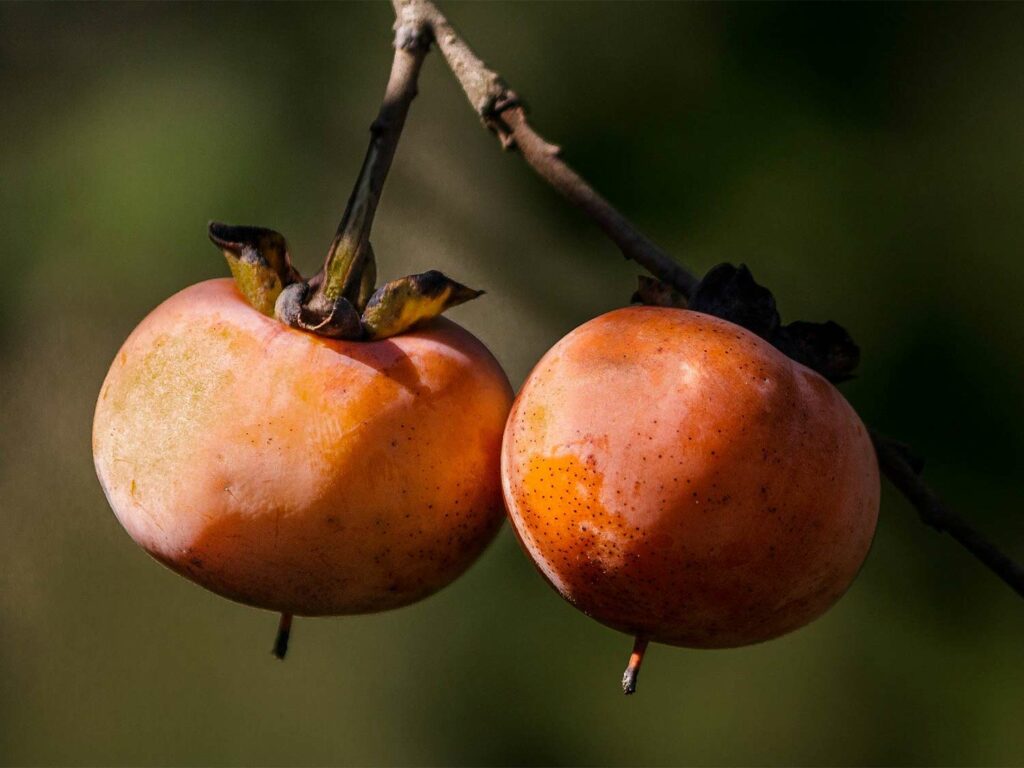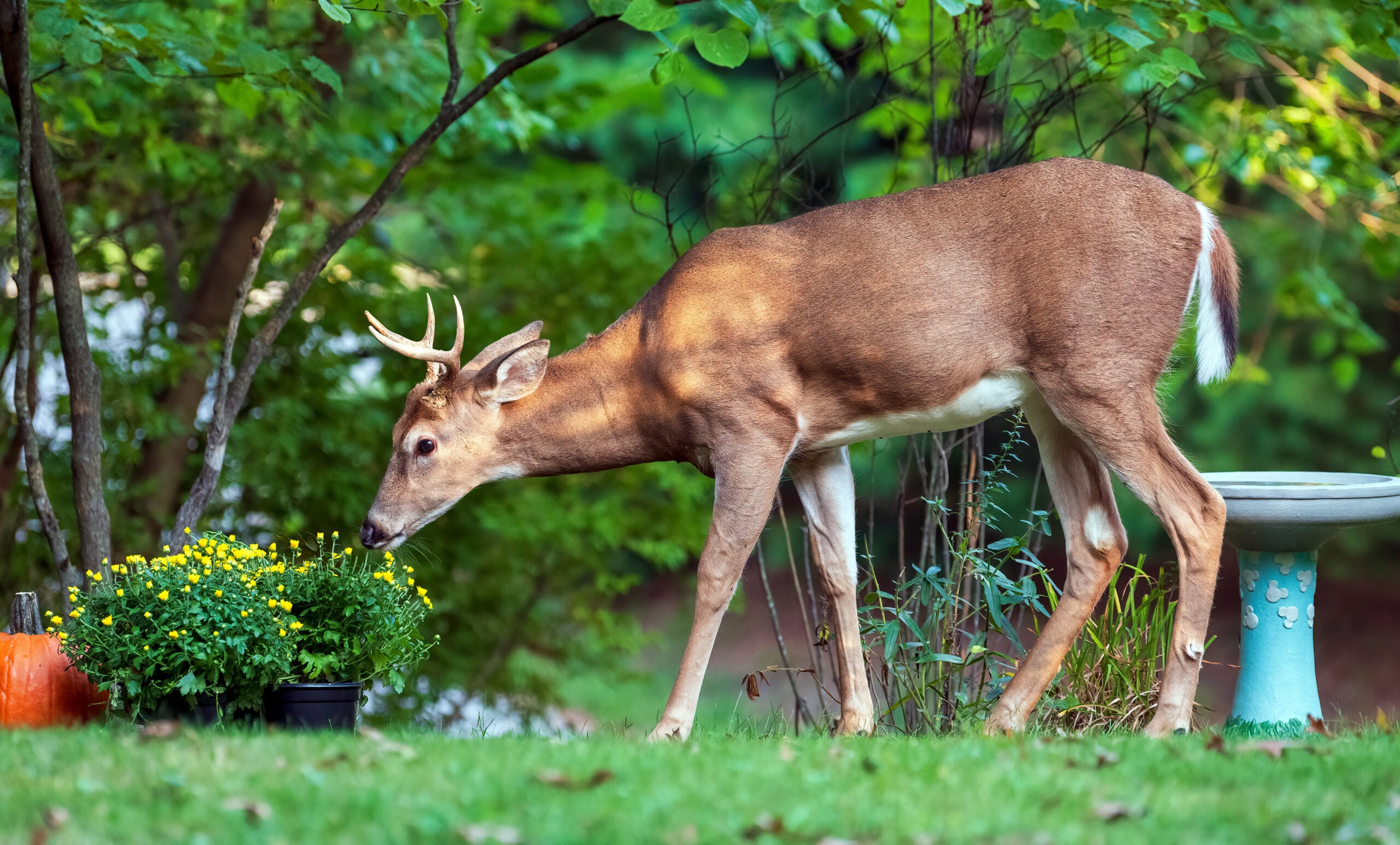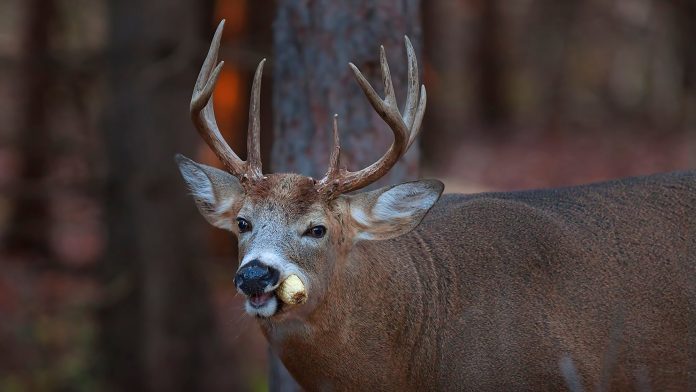The answer to What Do Deer Eat? includes just about everything that grows up from the ground or falls from a tree—including the tree itself. Given the choice between an apple, an acorn, and a clover shoot, a deer will eat all three. They’re nibblers. They like a good buffet. Deer may spend more time at the soybean or alfalfa station, but they are going to try everything.
One of the key reasons deer are so adaptable and successful as a species is because they can eat hundreds and hundreds of different foods. All manner of grasses, sedges, forbs, herbs, legumes, fruits, nuts, grains, roots, twigs, leaves, and even rodents and birds are on the menu. One study identified more than 400 plant species as deer food, and that was just in the Southeast. The overall number may be twice that. Luckily for hunters, deer do have favorites. For us, the question isn’t just what do deer eat but what foods are they most drawn to throughout the season—and so we’ll cover both.
What Do Deer Eat? Top 20 Favorite Deer Foods
While the full list of foods deer will eat is too long to print here, a rundown of their absolute favorite and most important foods is surprisingly short. The top 20 deer foods are: acorns, alfalfa, apples, beechnuts, brassicas, cereal grains, clover, corn, cowpeas, fall leaves, fir needles, forbs, milo, northern white cedar, persimmons, pears, saplings and shrubs, soybeans, and treetops (felled or fallen). Naturally, you could add, subtract, or substitute one or two depending on where you live, but generally, this covers the key foods deer hunters need to know and keep tabs on. So let’s break them down.
1. Acorns: The No. 1 Nuts

In his classic book, The Deer of North America, the great Leonard Lee Rue III writes: “I can state unequivocally that, in the northeastern, central, southern and west coast regions of the Untied States, acorns, when available, are the favorite whitetail food. There are times when acorns comprise 80 percent of their diet. When the acorns drop, deer forsake their regular haunts and most of the other available foods to feast on the succulent brown nuts.” Look for acorns that fall without caps, as they tend to have the fine, firm flesh that deer crave.
2. Alfalfa: Deer Eat It All Year
Deer relish this widely available perennial legume. They’ll hammer alfalfa as soon as tender shoots spout in spring and will keep eating all summer and fall, as repeated harvests promote new growth. Even in winter, deer will dig through the snow to reach alfalfa. As a food source for deer, alfalfa fields are never more attractive than when they are newly planted. Talk to farmers about their planting schedules, and hang stands accordingly.
3. Apples: Deer Candy

Deer like sweets, too, and when ripe apples begin hitting the ground, it’s like a new candy store just opened. Like us, though, deer can only eat so many sweets before moving on to something else. That said, a hidden orchard or even one heavily laden tree can be a first-stop destination for hungry early-season deer. And remember that deer will continue to hit orchards after the fruit is gone to browse on buds and twigs.
4. Beechnuts: A North-Woods Staple
Beechnuts are a key mast species where oak trees are absent or few, or when the acorn crop fails, especially in the Northeastern big woods. The beechnut crop can be hit or miss, but when they abound, you can bet deer will be on them. Scout beech stands before the season to gauge the crop.
5. Brassicas: Deer Love Them Late

One of the best food-plot options, especially for late-season hunting, brassicas (a genus of plants in the mustard family that includes rape, kale, turnips, rutabaga, radishes, and many others) are typically planted in summer or even early fall. The cold-tolerant plants provide green forage at a time when other sources have dried up, and deer will dig for the roots well into winter.
6. Cereal Grains: Deer Eat Them Early
Deer will hammer the tender, young shoots of rye, wheat, and oats, and deer hunters love these plants because they are so easy to grow. As a friend of mine says, cereal rye will damn-near germinate on pavement. If a summer plot fails, you can alway sow an annual cereal grain—even into fall—and still get a crop that pulls in deer.
7. Clover: The Low-Maintenance Plot
Just as they will with alfalfa, deer will absolutely swarm to a newly planted clover field, whether the farmer planted it or you did as a food plot. Clover can be a little tricky to get started, but once established, it makes for a low-maintenance perennial plot that will attract deer for years running.
8. Corn: The Game Changer

No one needs me to tell them that deer love corn. From a hunting standpoint, the most important thing is to keep close tabs on the harvest. A freshly cut cornfield, early or late, can be a game changer. When a farmer fires up the combine, it’s suddenly a race between deer and other critters to clean up the waste grain. That’s why deer will suddenly abandon other food sources to follow the combine. You should too.
9. Cowpeas
Another popular food-plot plant, particularly in the South, cowpeas are heat-tolerant and so attractive to deer that you may need to fence your plot off until the season starts. Just remove the fence a week or two before the bow opener, put up a camera, and watch the deer pile in.
10. Fall Leaves: Yup, Deer Eat Them

Deer readily eat fall leaves and seem to prefer freshly dropped ones for their higher moisture content. Their favorite color: red, which has more residual sugar. Top species include dogwood, aspen, and maple. But there is one problem for hunters here: Good luck setting up an ambush on this food source.
11. Fir Needles: A Winter Staple
This is a list of favorite and most important deer foods, and while no deer is going to choose a fir needle over an acorn, apple, or turnip, many a winter deer in the West—muley, whitetail, and blacktail—would starve if it weren’t for the needles of fir trees.
12. Forbs: Overlooked Deer Eats
Forbs, sedges, and herbs that grow naturally in fallow fields, pastures, burns, prairies, alpine meadows, wetlands, and natural clearings are powerful deer attractants when green and tender, as well as when frosts make certain species less toxic and tastier. Up to 70 percent of a whitetail’s summer diet consists of forbs, including pokeweed, astor, ragweed, wild strawberry, and goldenrod, to name a few favorites. In fall, mule deer quickly devour frost-killed false hellebore, cow parsnip, and Russian thistle, as well as a long list of other herbaceous plants.
13. Milo: The Deer Bed and Breakfast
Milo, or grain sorghum, makes life easy on deer. Widely planted in the lower Midwestern and Plains states, it grows thickly enough to provide great bedding cover, and it’s a favored food source for both muleys and whitetails, which only have to stand up to get dinner. Often, the field of milo you’re glassing with have no deer one second and a couple of nice bucks feeding in it the next.
14. Mushrooms: Scattered Deer Snacks

Deer gobble up mushrooms whenever and wherever they find them. It’s a mystery how deer tell the difference between poisonous and non-poisonous varieties, but they apparently do. You may be thinking, Well, I’m not gonna hang a stand overlooking some mushrooms, but people actually do this. There are a handful of creative hunters who grow wild mushrooms as a sort of in-woods food plot and hunt over their crops.
15. Northern White Cedar
Winter deer love northern white cedar so much that you can hardly find one growing in the wild anymore. However, if you hunt the suburbs, where these trees—also known as arborvitae—are frequently planted as ornamentals or as a border or windbreak, you’ll usually find them half eaten by deer. You may also find a homeowner who would love for you to take care of the problem.
16. Pears: A Rare Treat
You’ll not find a lot of pear trees growing wild, but when you do, you should probably hang a stand nearby. Deer can’t resist pears, and once your tree or trees start dropping fruit, deer are bound to show up.
17. Persimmons: A Southern Thing

If you’re a northerner, you’re more likely to find a pear tree than a persimmon. But if you hunt down south, these fruit trees are reasonable common and, like pears, their fruit is all but irresistible to deer. Keep tabs on the crop, because once the fruit starts falling, it won’t last long.
Bonus Items: While apples, pears, and persimmons are tops, other fruits can be important locally. Deer love wild berries wherever they are available and ripe, but they also eat the leaves and stems of raspberry and blackberry plants well into fall. Deer also eat sumac wherever the fruit grows low enough for them to get at, and I’ve watched late-season deer spend hours under a honey locust trees, eating the long brown pods.
18. Saplings and Shrubs: Deer Eat Them or Die
This is another one that is probably more important and favored. Critical, in fact, as deer cannot survive without eating the leaves, twigs, and buds of woody browse, which usually means saplings and shrubs, as well as some vines (see a list of key species below). Deer need to eat browse wherever then live, but in big-woods habitats, away from food plots and ag fields, the young woody growth that shoots up in recent cutover areas becomes prime food sources—ones that hunter need to pay close attention to.
19. Soybeans

Another top food-plot planting and, of course, a common agricultural crop, soybeans are deer magnets, both early and late. In summer and early fall, deer will absolutely hammer the green foliage of soybean plants. Their appeal tapers off as the leaves turn yellow, but later, when the pods mature and dry, soybeans become a huge late-season draw for deer.
20. Treetops: Deer Come When They Fall
When the leaves, twigs, and buds of treetops suddenly become available to deer after a wind storm or a logging operation, they’re going to take advantage, especially in the late season when other food sources are scarce. I’ve seen late-season deer pound a trail to recently fallen or felled treetops, creating an instant hotspot.
What Do Deer Eat? Key Browse Species

Browse is so important to deer that it deserves a section all its own. Unlike agricultural crops and mast, the leaves, twigs, and buds of small woody plants stimulate the microbes in a deer’s rumen, which is critical to digestion. They can’t survive without them.
A whitetail needs to consume 7 to 10 pounds of browse every day, which means that good deer habitat needs to include plenty of brush, shrubs, saplings, and vines growing low enough for them to reach. Top browse species include the following.
- Ash: It often grows in low-lying sites preferred by wintering or pressured deer.
- Aspen: It’s a staple in industrial forests and other areas of aggressive logging activity.
- Bitterbrush: It’s a highly digestible favorite of mule deer
- Dewberry: This vine offers tender shoots that southern deer favor, and it maintains edible leaves well into winter.
- Dogwood: Gray dogwood is an important brown species in the eastern half of the country; red osier is key east and west
- Greenbrier: The blue berries of this widespread thorny evergreen vine can last well into November, and the leaves are favorite all winter long.
- Honeysuckle: Another favorite vine whose leaves often remain attached well into winter.
- Maple: The leaves, twigs, and buds of red, sugar, and striped maples are all favorites.
- Mountain Laurel: Without the high-protein leaves of this plant, winter deer would starve in some areas.
- Poplar: Muleys relished the yellow leaves and the buds of low or fallen branches.
- Sagebrush: Not favored, but it’s an important winter species for mule deer because of its availability.
- Willow: It’s widespread in western riparian habitats and a key browse species for whitetails, muleys, and blacktails.
What Do Deer Eat in Your Lawn and Garden?

Hunters have lawns and gardens, too, and suburban hunters might even hang a stand not too far from one or the other. Either way, it’s good to know which landscaping and garden plants deer will devour. The Old Farmer’s Almanac lists hostas, daylilies, and English ivy as “deer candy.” If that the case, then I’d say arborvitae, yew, and rhododendron are the main course. So, whether you’re choosing plants for your own lawn and garden or scouting a suburban bow-only area, here’s a short list of cultivated plants that deer will come running to.
- Arborvitae
- Yew
- Azalea
- Rhododendron
- Cherry trees
- Crabapple trees
- Bittersweet
- Privet
- Honeysuckle
- Holly
- Indian Hawthorn
- Hosta
- English Ivy
- daylilies
- Roses
- Tulips
- Sunflower








